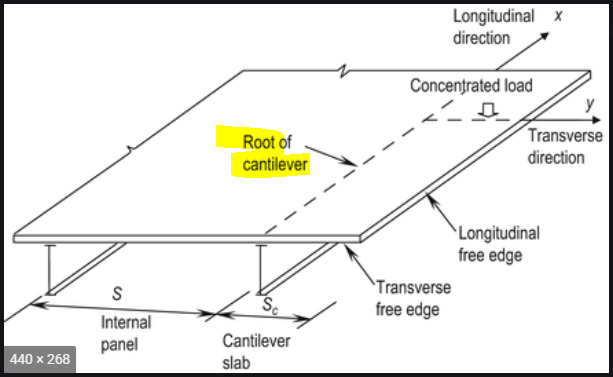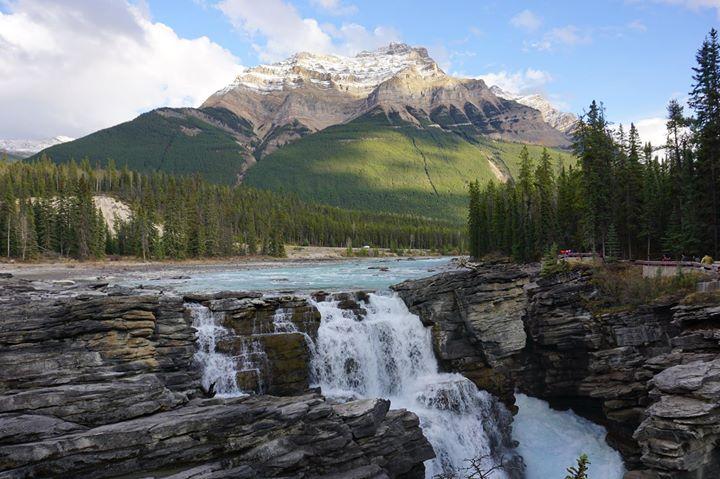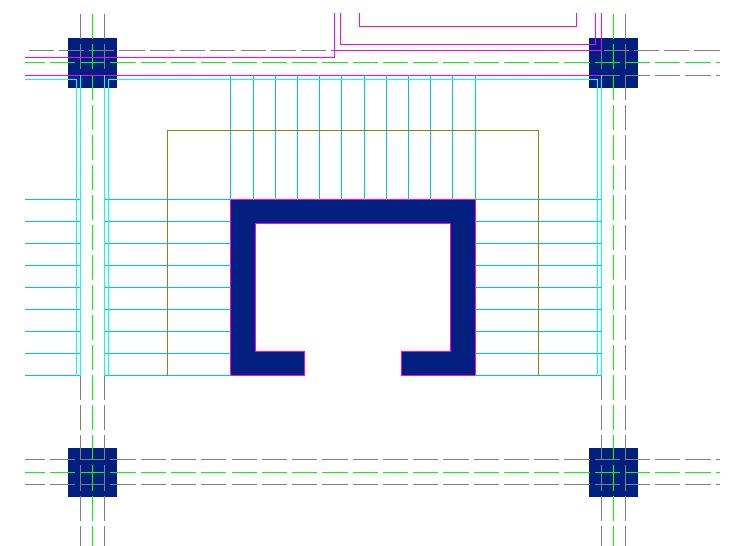-
Posts
1470 -
Joined
-
Last visited
-
Days Won
444
Content Type
Profiles
Forums
Events
Posts posted by UmarMakhzumi
-
-
Is the Barrel Section a vertical section or a horizontal section? Looks more like a horizontal section to me, but I could be wrong as not familiar with these.
On 5/1/2021 at 1:47 PM, hali said:he A1 bars in the top slab are #6 bars, so their basic development length is about 14.5". Now this was not developed into the walls because I'm assuming you cast the slab last so the concrete in the walls has already matured. But shouldn't it have 180 degree hooked bars at least?
A1 bar is for +ve moment (Sag, where tension is at the bottom) and likely the location of moment would be in the center (assuming) so you don't need to develop it with hooks as not required and rebar is developed at critical section.
On 5/1/2021 at 1:47 PM, hali said:Now this was not developed into the walls because I'm assuming you cast the slab last so the concrete in the walls has already matured.
The dowels from the wall are protruding even if the wall is casted first. The dowels go in slab and will be covered by slab concrete.
On 5/1/2021 at 1:47 PM, hali said:Also I don't think this wall-slab connection can be considered a simply supported one since rebar is being developed from both layers from the walls.
If there is no force reversal, you only need to develop the negative rebar for gravity loads to consider the wall-slab join as fixed which they have.
Thanks.
-
Hello Everyone,
I got an email from a new member that he was facing problems with the validation email that is sent when a new account is created.
I have manually approved a few members but I am looking for feedback. If other member have faced the same issue, please let me know.
Thanks.
-
Hali,
The above reply is excellent. To make things more lucid, I will add the following to above answer.
7 hours ago, hali said:I think its the point beyond which we need to ensure development
Correct.
7 hours ago, hali said:At a wall-slab joint where both the slab and wall are 8" thick, if #6 bars at 8" c/c need to be developed from the slab into the wall, I found that even with the 90 degree hook, the development length is at least 14". How do you satisfy development length in such a case?
There are different ways. Certain Codes allow low/ non-seismic applications to reduce development length by As provided\ As required ratio (including ACI). Other options include mechanical anchors, assuming pin condition in analysis like Baz mentioned above and increasing the size of members.
7 hours ago, hali said:For hooked development length ldh, is it the length up to the hook or is the length that includes the length of the hook?
Ldh is length up to hook. Don't add 12*Db.
7 hours ago, hali said:This stuff has been eating up gray matter from my brain for a few days now.
Haha. You are doing great. These are good signs.
Here is tip. If you already don't have, get a copy of PCA Notes on ACI, and see examples in that document. It will clear up any ambiguity that you have and also it serves as good reference.
Thanks.
- abbaskhan2294 and Badar (BAZ)
-
 1
1
-
 1
1
-
2 hours ago, Kamran ullah said:1 hour ago, Wajahat Latif said:
I don't think this core wall will participate in lateral resistance since its not connected to the slab. For that reason, I think it shouldn't be modeled.
Your case is tricky. Your shear walls will still resist load but differently. To see that happening, you will need to model the stair slab (diagonal & Landing). Also please see this thread:
Thanks.
-
On 4/17/2021 at 4:13 PM, Kamran ullah said:
"So the most economical and effective way to reduce drift is to increase beam depths (and slab thicknesses as well)." as Depth is restricted
By increasing the Width of Beams decreases the Drift or Not ?
Depth will help for the case of moment frame. Width can have a very minor to negligible effect as contribution of beam width to moment of inertia is small.
- Ayesha and Kamranullah
-
 2
2
-
On 3/30/2021 at 1:57 AM, Rimsha said:
Concrete box culvert design on CSI bridge, if we restrained bottom by fixed support than answer of moments and shear are coming less???? And shear and moments should come more on bottom slab than top???? Plz guide
Yes, I think you are right. Should be less moments in the middle and more at the end. (to be clear)
PCA has a publication where coefficients are provided for 2 way slab bending based on boundary conditions. I believe it was also posted in the forum some time back. You can use that.
Thanks.
-
Strong column, weak beam. @Badar (BAZ) is our expert on this topic. I believe he can shed some light on beam column ratio etc.
-
On 4/9/2021 at 4:06 AM, JL07 said:
Hello,
What I found is that the issue comes up only when I work with Microsoft OneDrive activated. When I close Microsoft OneDrive and run the model, it works normally. This is probably the reason why etabs technical support wasn't able to reproduce the error.
Thank you all for your replies and help.
Thank you for updating on this. If someone else gets into the same issue in the future, your post would be of great help to them.
-
On 4/11/2021 at 7:42 AM, Muhammad Hashmi said:
Assalam O Alykum
I gave very hard interview questions (at least for me )in famous international engineering consultancy on Microsoft team. Might be it looks very easy for many of you.
Just want to share my experience. If seniors can have a look on the questions which i remember and my replies to them. I believe should not ask with a guy having less experience. However, I am expecting to receive positive response.
Questions are underlined ,but not in sequence.
Thank you
Interesting. Thanks for sharing.
-
On 4/9/2021 at 4:28 AM, Azshah said:
i want to ask if the columns of an RC multistory building have to pass both as "reinforcement to be checked" and "reinforcement to be designed" in ETABS V16.
i am working on a project in which when i select the option of reinf. to be checked and provide reinf., the design is ok. whereas if on the same model when i select the option of
reinf. to be designed, failures are shown such as BCC failures.
i presume a structure has to pass both.
guidance is needed
Azshah,
Reinforcement to be checked should be used when you "Define" the column reinforcement and provide the steel which you plan to provide on drawings. Normally this option is used when you are checking existing brown field structure where reinforcement is known.
When you want ETABS to design the reinforcement (tell you how much is required), you go with reinforcement to be designed and provide that reinforcement.
Thanks.
-
W.salaam,
My suggestion would be that you still use the minimum specified yield strength of 460 MPa, as you are testing limited number of bars out of of thousands of bars that will be used for the structure. Also, it is good to keep some contingency as there are a lot of assumptions and limitations involved.
Thanks.
-
Clean website and useful information.
Thanks for sharing.
-
There is one tutorial on CSI Wiki for SAP2000. You can see if the same feature is in ETABS. I can't check as I don't have ETABS copy with me.
https://wiki.csiamerica.com/display/tutorials/Radial+point+load
Please download the attachment, report.pdf and read it.
Thanks.
-
On 3/31/2021 at 10:39 AM, abbaskhan2294 said:
So the backspan has to counteract same moment as that of the cantilever.
Backspan is there as it needs to meet development requirement. That is the only purpose.
What Baz is referring to is the Stability Requirements at Cantilever root (see snapshot below for understanding). What that means is that your beam at location where it is supported on the wall should have lateral stability (either other beams coming from the side frame into your cantilever beam, or something stopping your cantilever beam from twisting). These requirements are well understood in steel design. I am attached a document that can provide you some insight from steel point of view. You can take that understanding related to stability and apply to concrete.
Thanks.

-
Welcome to the forum Kaleemo. Glad to have you on board.
Thanks.
-
On 3/6/2021 at 12:39 AM, Attiq ur Rehman said:
2-multiply the modulus of subgrade reaction with area of pile.
Dear Ilyas Sb.,
Is it the cross sectional area or frictional area of pile?
Vertical springs stiffness is obtained by dividing the load on pile by its deflection. Geotechnical provides recommendation on how to calculate pile deflection.
The above post by @ILYAS is about horizontal pile spring. The area is the side area (Pile dia * height b/w spring) not the cross-section area.
-
7 hours ago, Muhammad Hashmi said:
"Any code that recommends the safe boring distance between piles"
Hashmi,
For steel piles that are hammered/ driven in the ground: 2.5 * Outer Diameter of the pile is the minimum distance that is kept in Canada (I think this comes from Canadian Foundation Engineering Manual but can't recall the reference). This is out general accepted practice but normally we want to keep the minimum distance as 3.0* Outer dia of pile. If that can't be achieved then we go for 2.5*D but never lower than that. Sometimes, the piles will heave a little out of ground when adjacent piles are being driven (even with keeping 2.5-3 *D) distance. Such piles should be re-tapped.
Thank you.
-
Hashmi,
I am not sure if I get the question right, but can you please check this thread and post any follow up. I think what you are asking is answered there. Please let me know.
Thank you.
-
I can answer any question posted here.
-
On 2/26/2021 at 6:21 AM, Kamran ullah said:
The general practice in a lot of design firm in Pakistan is to design the shear walls with 100% of base shear even if you you opt for dual system and to design the frame for at-least 25% or more.
-
W.Salaam,
There is a lot of recent posts on the forum about designing masonry in ETBAS/Safe. I would suggest you to search the forum to get the required answer. However, please note that we don't recommend using ETABS for Masonry design as it is a frame analysis software. You should either try locating a masonry design software or buy a masonry text book and follow the examples.
Regards,
-
Tahir,
I do hope you can find someone that can walk you though. The important thing would be to design for wind and the connection of container to your foundation.
-
-
Wajahat,
On 2/9/2021 at 12:51 AM, Wajahat Latif said:1. Should we not consider P-Delta effects in computing drifts? If so, can you provide a reference where either UBC or ASCE state this.
I don't use American Codes anymore. You can check them to see what the requirements are. P-Delta analysis in my opinion, should be included irrespective of what code says.
On 2/9/2021 at 12:51 AM, Wajahat Latif said:2. Should the drifts be computed against seismic load cases (EQX, EQY) only or against load combinations? (If we're using P-Delta analysis then the gravity loads in the load combinations would amplify the drifts)
This is code specific. For UBC, yes, for other please check the relevant code. If P-Delta is increasing your drifts to the extent that avoiding it is making your results pass then I guess your structure is super slender and you should beef up your framing.
On 2/9/2021 at 12:51 AM, Wajahat Latif said:3. If we're computing drifts against the unfactored EQX and EQY, then shouldn't we use the ACI stiffness factors provided in Table 6.6.3.1.1(a) multiplied by 1.4 as per ACI 6.6.3.2.2. I suppose this would give the same stiffness factors of 1.5 you've stated in your post.
I am note sure which 1.5 are you referring to. For stiffness modifiers, there are some recent discussions on the forum that you can find helpful. I am a bit rusty on them and apparently new ACI has changed a few things with regards to stiffness modifiers.
Thanks.



Hooked development length (ACI/AASHTO) - space constraints, critical sections and length of hooked part
in Concrete Design
Posted
It should be. The B2 Bar X Dimension should be long enough to develop so that fixed end connection can be satisfied.
I am not sure what assumptions they had for the design. Do you have any way to get intouch with them and clarify this?
Thanks.